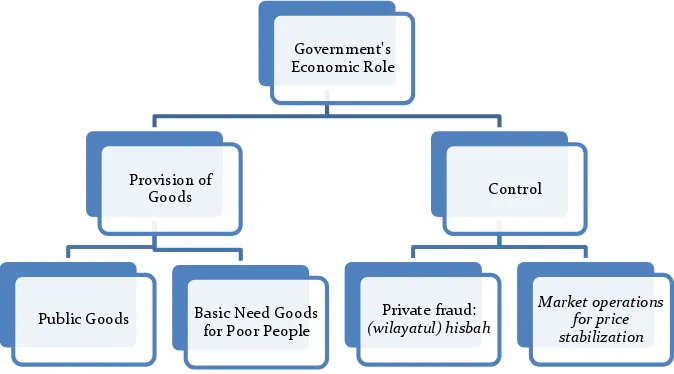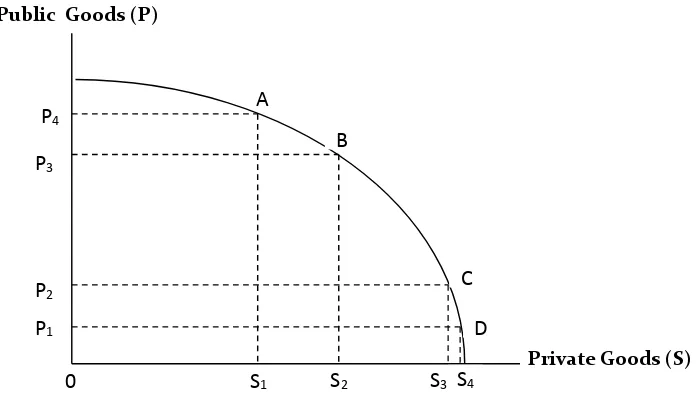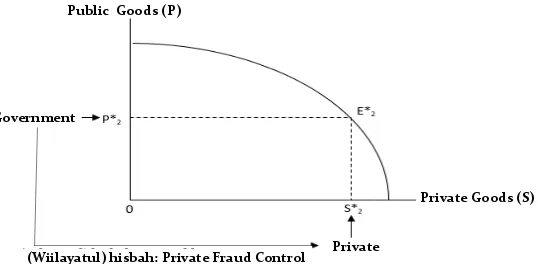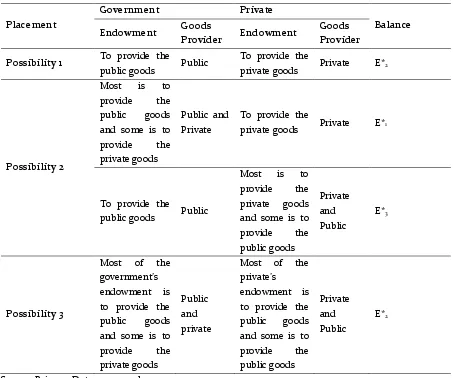JEJAK
Journal of Economics and Policy http://journal.unnes.ac.id/nju/index.php/jejak
Analysis of Mixed Economic System in Islamic Perspective
Agung Riyardi1 , Purbayu Budi Santosa2
1 Muhammadiyah University of Surakarta; 2Diponegoro University of Semarang, Indonesia Permalink/DOI: http://dx.doi.org/10.15294/jejak.v8i2.6165
Received: July 2015; Accepted: August 2015; Published: September 2015
Abstract
This study tries to analyze a mixed economic system based on the Islamic rules. It is regarded as an ideal mixed economic system because the goverment plays plays the role in the economic system. Nowdays, many concepts of mixed economic system come up but it cannot be said as the ideal ones due to the economic actors’ greediness in interfering the systems. The method for analyzing data is placing the goverment and private sectors appropriately at a curve of possibility of producing the private-public goods. There are some findings. The first result shows that the goverment does not need to conduct the market operation and the price interference with the assumption that the poor can meet their basic needs. Then, Islam views that mixed economic system is the ideal one if the goverment and the private sector play roles in the system. The role of goverment is to provide goods for the public and to control the private sectors. Further, the private sectors provide goods for the needs of private. Finally, the finding also shows that there is greediness that appears at the goverment and the private sectors.
Keywords: mixed economic system, government, and private roles, Islam
How to Cite: Riyardi, A., & Santosa, P. (2016). Analysis of Mixed Economic System in Islamic Perspective. JEJAK: Jurnal Ekonomi Dan Kebijakan, 8(2), 126-136. doi:http://dx.doi.org/10.15294/jejak.v8i2.6165
© 2015 Semarang State University. All rights reserved
Corresponding author :
Address: Ahmad Yani Tromol Street Pos 1, Pabelan Kartasura, Central Java
E-mail: agung.riyardi@ums.ac.id
INTRODUCTION economic system characterized by the domination of private and government. This system was born of the rapid changes in the economic phenomena that produced the new type of economy (Bogolib; 2013).
Mixed economic system has been used as an economic system of many countries in the world. Mixed economic system is also used in Indonesia (Seff, 2010). Even Hatta (1963: 41) had described the form of a mixed economic system in Indonesia in the form of domination of the state to work on large business, cooperatives for small things, and domination of the private to seek their own capital and labor. In fact, in many countries, the domination of private and government domination is very subtle, and none of the countries which economic system is dominated only by the private sector or the government.
Differences that exist among various countries are only on the degree of the
government’s domination in a mixed
economic system. Perhaps in a country the degree of government’s domination is low or moderate, while in other countries the degree of government’s domination is high. For example, according to Velinga (2009), the governments in (Southeast) Asia and Latin America are very dominating in the economic development. Nevertheless, they are known as the countries with the mixed economic system. Another difference is the use of a special name for a mixed economic system that is adopted by a country. In
Indonesia, for example, a special name for a mixed economic system is economic democracy (Abbas, 2008), while in Malawi in the year of 1964 to 1980 it is called unilateral capitalism (Kayuni, 2011), and in China that intensively reforms the economic openness it is called Socialism in China culture (Tisdell 2008).
Based on the nature and reality of the mixed economic system, this paper aims to analyze a mixed economic system in the perspective of Islam. The underlying assumption of this paper is the possibility of a mixed economic system with non-ideal pattern. The arguments that can be presented of a mixed economic system that is not ideal is the human greed that not only causes the excessive utilitarianism as proposed by Chapra (2000: 26), but also causes so much domination of public or private that will be detrimental to all parties.
Even greed can lead to collusion between the government and the private sector that in the short term, according Santosa (2014: 162), preserves the poverty, unemployment, economic inequality, environmental damage, and causes the social pathologies. Other argument is the more value of the teachings of Islam that not only teaches the system of worship, but also a variety of living systems, including as told by Al 'Assal and Karim (1980: 10) and Bashir (1987: 1) in the form of an Islamic economic system that would be rahmatan lil 'aalamiin
and able to eliminate the human greed, which is different from the economic system of capitalism and socialism, as stated by Qardhawi (1995: 18-21).
the concept of a mixed economic system that is ideal and not greedy. Even it opens a space for comparison of the economic system in the economic role of the state and the private sectors. This article is also beneficial for the stakeholders of the mixed economic system. They can consider it for participation that is not based on utilitarianism and greed and is according to the teachings of Islam about the economy.
Mixed economic system focuses on the problem solution of production and exchange of resources, goods and services, while the institutional and agency are not the focus of it. Even adopting the institutional
There are three models in the adoption of institutional and agency of capitalism or socialism. The first model is the model that avoids the shortcomings of economic system of capitalism and socialism. The second socialism. Although each model is different in the adoption of systems, all three have similarities in the way of adoption, namely the hope that will resolve problems of production and exchange.
The first model is represented by Muhammad Hatta, which according to Abbas (2008) argued a lot about the shortcomings of western capitalist economic system such as secularism, individualism and free fight
liberalism. If the various shortcomings are not avoided, it will damage the noble values such as democracy, cooperation and criticism, and even it will lead to the domination of private monopoly and no involvement of the state so there is no prosperity and economic and non-economic welfare.
The second model emphasizes that the economic systems of capitalism and socialism have various benefits that are needed, but these benefits are not owned by other economic systems. Hence, the usefulness of the economic system is taken as needed. An example is the economic system of socialism that is considered to have benefits in terms of economic domination by the state, and then the domination is adopted and used to control and intervene in the economy. Another example is the economic system of capitalism that is considered to have benefits in the individual ownership and it is adopted by a mixed economic system and used to motivate the domination of private sector in the economy. It may be said that the adoption of this second model is a model of Benefit, Adopt and Use (BAU), which is useful, take and use it.
Keynes to overcome the economic crisis at that time, which was also useful to prevent the development of socialism. As for today, the pendulum is back to 'heavy' towards the domination of the private-called neoliberalism through the reduction of the role of government to strengthen the economic growth, although there are many critics, such as a criticism of causing the environmental damage.
Various literature on the role of government in the economy according to the teachings of Islam rests on an overview of the government's two roles: a role as a provider of goods and a role of controlling the economy. As shown in Figure 1, the government's role as a provider of goods can be divided into two those are the role of government as a provider of the basic needs and the role of government in the provision of the public goods. The role of government in the provision of goods is due to the hadith of the Prophet that states: "Imam is a servant and he will be asked for his responsibility as his services". For example, the government must provide the basic need food for the poor and people who are not able to meet their own needs.Likewise, the government should provide the public goods that people need, such as highways, hospitals, or schools.
This had ever been taken by the caliph Umar bin Khattab, who was shouldering a sack of grain at night to be given to a mother and her children who suffered from hunger, and immediately repaired the damaged road that harmed a horse pulling carts (al-Qudsy and Rahman, 2011). Such is a little picture of the reality that government in Islam teachings plays a role in the provision of goods. Therefore, in Islam, the government serves the people in the fulfillment of basic needs and public goods.
The role of government in the form of controlling on the economy can be divided into two. The first is controlling over the various economic fraud in the community. The first role is known as a (wilayatul) hisbah
role. Law enforcement officials (judges) will always be around in the middle of the market and the public places. When encountering and proving the fraud, the government official is authorized to immediately stop such fraud so that there is a protection on the consumer (Khan, 2011). Second is the control of improper price of goods. In this case the government controls it by doing 'market operations' to increase the amount of goods and to lower the price level back to the fairness. The government does not control the economy through price caps.
Figure 1. Government’s Economic Role According to Islam
Government's Economic Role
Provision of Goods
Public Goods Basic Need Goods for Poor People
Control
Private fraud:
(wilayatul) hisbah
There are allegations that the Islamic government can narrow the price. Islahi (1999) for example, who was based on the opinion of Ibn Taymiyyah, suspected that the government may intervene in the price. But if you pay attention more closely on the opinion of Ibn Taymiyyah to discuss the role of
(wilayatul) hisbah in controlling economic
fraud, the alleged role of government in influencing the price is not right. More precisely, as stated by Riyardi (2013), the government plays the role in controlling the economic fraud and does not intervene in the price. Thus the government’s role is tangible in controlling the economic fraud controls through (wilayatul) hisbah and controlling the impropriety of prices through 'market operations', which are not an intervention and the price restrictions.
RESEARCH METHODS
The method used in this analysis is a method of ideal position placement of the private and government in the providing of private and public goods based on the possibility curve of the production of
private-public goods. This method puts the private and the government by paying attention to the assumption of full employment in such a condition that any attempt to add a private good brings impact on the reduction of more resources of the government sector, and vice versa, as in the concept of possibility curve of production of private-public goods. Thus, this method is appropriate to examine the
government’s economic role in the Islamic
way and the Islamic mixed economic system.
RESULTS AND DISCUSSION
Figure 2 below shows the production possibility curve of private and public goods and the concepts in it. It is seen that the economy produces the private and public goods at the possibility of points A, B, C or D. The change in production from point A to point B makes the private goods produced more with the 'cost' in the form of reduced production of public goods. The change in production from point A to point C makes the private good produced more, but with the 'cost' in the form of more reduced production of public goods, which is 0P3-0P1> 0P2-0P1.
Figure 2. Possibility Curve of Production of Private-Public Goods
Private Goods (S) Public Goods (P)
A
B
C
D
0 S1 S2 S3 S4
P1
P2
P3
And vice versa, the change in production from D to C makes the public goods produced more with the 'cost' of reduced production of private goods. The change in production from point D to point B makes the public goods produced more, but with the 'cost' of more reduced production of private goods, which is 0S3-0S1> 0S2-0S1. Thus, the private and the government need to be careful in the role of producing the private and public goods, because their role will affect the 'balance' of the production of private-public goods needed by the people. There are three possibilities for the placement of role of government and private. The first placement possibility is the placement of government as a provider of public goods and the placement of private as a provider of private goods. The second is the the placement of government as a provider of public and private goods, while the private as a provider of private goods. The third is the placement of government as a provider of public and private goods, while the private as a provider of private and public goods. Figure 3 shows all possible placements. Possibility 1 illustrates that the government only produces the public goods and the private only produces the private goods. The combination produces a balance production of E*2, in which the public goods produced by the government are as many as P*2 and the private goods are produced as many as
S*2. Possibility 2 illustrates that the government also produces the private goods resulting in the balance production of E*1 or the private also produces the public goods resulting in the balance production of E*3. To achieve a balance production of E*1, the government uses most of the endowment to produce the public goods as many as P*1 that is less than P*2 and uses the remaining endowment to produce the private goods valued S*2 - S*3 so that the total of all private goods is S*.
As for reaching the balance production of E*3, the private uses most of the endowment to produce the private goods as many as S*1 that is less than S*2 and uses the endowment remaining to produce the public goods valued at P*2 - P*3 of the private so that the total of all public goods is P*3. The possibility 3 illustrates that the government and the private produce the public and private goods. If you assume that the starting point is the balance of E*2, the government produces the public goods and the private produces the private goods less than the production in the balance of E*2, but the production balance stays at E*2 because the government produces the private goods as many as S*1 - S*2 and the private produces the public goods as many as P*1 - P*2. The balance resulted is the same as Possibility 1, which is a balance of E*2. Resulting balance is equal to 1 Chances are, namely the balance of E*2.
Figure 3. Three Possibilities of Placement of Government and Private in Provision of Public and Private Goods; (a) Possibility 1
Public Goods (P)
Private Goods (S)
Private Government
Figure 4. Three Possibilities of Placement of Government and Private in Provision of Public and Private Goods; (b) Possibility 2 and 3
The comparison among the three possibilities may be seen in Table 1. The comparison includes the use of endowment and the provision of goods conducted by the government and private sector and the production balance produced. The possibility of placement 1 is different from the possibility of placement 2. The differences are in the use of endowment, the role of government or the private sector in producing the public and private goods, and the balance produced. Likewise, the possibility 1 is different from the possibility 3. The differences are in the use of endowment and the role of government and the private sector in producing the public and private goods. At every possible placements, there is the role of government as wilayatul hisbah, which is the role of government to correct the private fraud in the provision of goods. In Figure of Possibility 1, the government plays the role as overseeing the private sector in providing the private goods, while in Figure of Possibility 2 and 3, the government plays the role as overseeing the private sector in providing the private and public goods.
Mixed economy according to the teachings of Islam is a mixed economy that places the government and the private sector in the ideal position. This ideal mixed economy is if the government and private are positioned in accordance with possibility 1. Endowment is used maximally, the government focuses on providing the public goods, the private focuses on providing the private goods, and the balance is the essential one.P
Possibility 1 is more ideal than possibility 2 because possibility 1 has the essential production balance. It is also more ideal than possibility 3 because the endowment of government and private is used maximally and the roles of government and private are focussed on the provision of the public and private goods. Possibility 1 is the most ideal one among possibility 2 and 3. Possibility 1 represents an ideal Islamic economic mixture. The ideal position of the role of government and the private in the perspective of Islamic teachings is that when each produces in accordance with its 'specialization'.
Public Goods (P)
Private Goods (S)
(Wiilayatul) hisbah: Private Fraud Control
Private and Government Government and
Table 1. Comparison of Possibility of Placement of Government and Private in Provision of Public and Private Goods
Placement
private goods Private E*2
Possibility 2
private goods Private E*1
To provide the Government and the private sector are in the ideal position as the providers of public the government to control the private fraud.
The impact is that the private really produces the private goods as many as S*2.
The differences are in the position of the role of government and private sector, in which the mixed economic system based on the teachings of Islam prioritizes the aspects of ideals of the government as a producer of public goods and the private as a producer of private goods as shown in Figure 3a, while other various models of mixed economic system does not prioritize the aspects of ideals as shown in Figure 3b. The institutional and agency of the government and private is not taken from a deficiency or excess of capitalism and socialism. Likewise, the institutional and agency of the government and private is not like a pendulum which orientation is technically able to change the direction into capitalism or socialism. The institutional and agency of the role of government and the private sector based on the teachings of Islam is
maximizing the government’s endowment in
providing the public goods and the private’s
endowment in providing the private goods. Another difference is in the role of government in the mixed economic system based on the teachings of Islam as wilayatul
hisbah. The government plays the role in
controlling the provision of private goods. The role of hisbah wilayatul is only known in a mixed economy based on the teachings of Islam and otherwise unknown in other mixed economy. goods and the private’s providing the private
goods maximally. The second is the government control over the provision of goods by the private sector.
Meaning of Economic Greed
Meaning of economic greed according to the teachings of Islam can be seen from the use of endowment and the roles of government and private in Possibility 2. Greed is the use of endowment for the production activities that do not prioritize the aspects of ideals. Economic greed is the government greed in using a small portion of its endowment to produce the private goods and make the production of public goods not maximum, or the private greed in using a small portion of its endowment to produce the public goods and make the production of private goods not maximum.
When both parties, the government and the private sector, conduct the economic greed, as shown in Figure 3, the production balance is in a position as at possibility 1, which is the ideal balance. It is caused by the 'compensation' for the reduction of 'specialisation' remains an economic greed although the state of production balance can be maintained at an ideal balance.
CONCLUSION
ideal mixed economic system. There are
three possibilities for the placement of
government and private sector in the
provision of public-private goods. Among
the three possible placements, the possibility
that puts the government as a provider of
public goods and the private sector as a
provider of private goods is an ideal
possibility because there is no economic
greed at that possibility. The institutional
and agency of the government and private
are in the ideal mixed economic system. The
governments provides the public goods and
controls the private fraud, and the private
sector provides the private goods.
This article assumes that the ideal
mixed
economic
system
is
able
to
demonstrate the
government’s
role in
providing the basic needs for the poor, to
show the government's role in controlling
the instability of private goods price through
the market operations, and not to intervene
in the price. However, the limitation of
model of the possibility curve of the
production of private-public goods makes
these assumptions not shown. In the future,
it is suggested about the explanation that will
describe an ideal mixed economic system in
the
government’s
role to provide the basic
needs for the poor and to control the price
instability of private goods through the
market operations, and that the government
will not intervene in the price.
There will also be opportunities and
challenges to discuss the comparisons
among the economic system of capitalism,
socialism, and Islam in a mixed economic
system. Assuming that there is a mixed in an
economic system, in which there is always
the roles of government and private sector, it
can be asked about the differences in private
and public roles in the provision of goods
333) called as merely "Put the old wine into
the new bottles".
REFERENCES
Abbas, A. 2008. Menangkap Nilai-nilai Demokrasi Ekonomi: Menurut Bung Hatta. Jurnal Equilibrium 5(3). 305-332.
Al 'Assal, A.M. dan Karim, F.A.A. 1980. An-Nizhaamul Iqthisaadi fil Islam Mabaadi'uhu wahdaafuhu, terj. Abu Ahmadi dan Anshari Umar, Sistem E.konomi Islam Prinsip-prinsip dan Tujuannya. Surabaya: Bina Ilmu.
Al-Qudsy, S.H.S.I. dan Rahman, A.A. 2011. Effective Governance in the Era of Caliphate `Umar Ibn Al-Khattab (634-644). European Journal of Social Sciences. 18(4). 612 – 624.
Basyir, A.A. 1987. Garis Besar Sistem Ekonomi Islam. Jogyakarta. BPFE.
Bogolib, Tetiana Maksimovna. 2013. The Public Sector of Mixed Economy in the Modern World.
Quarterly Journal of Economics and Economic Policy Vol 8 Issue 1, 2013
Chapra, U.M. 2000. Islam and The Economic Challenge, terj Ikhwan Abidin Basri, Islam dan Tantangan Ekonomi. Jakarta: Gema Insani Pers. Hatta, M. 1963. Persoalan Ekonomi Sosialis Indonesia. Development PolicyChoices from 1964 to 1980: An Epitome of ‘Pragmatic Unilateral
Capitalism’. Nordic Journal of African Studies
20(2). 112–131.
Khan, M.A. 2011. The Role of Islamic State in Consumer Protection. Pakistan Journal of Islamic Research
8. 33-44.
Mannan, M.A. 1993. Islamic Economics: Theory and Practice, terj. Nastangin, Ekonomi Islam: Teori dan Praktek. Jogyakarta: PT Dana Bhakti Wakaf.
Qardhawi, Y. 1995. Musykilah al Fakr wakaifa 'Aalajaha Al Islam, terj. Syafril Halim, Kiat Islam Mengentaskan Kemiskinan. Jakarta: Gema Insani Pers.
Prishardoyo, Bambang, Karsinah. 2010. Analisis Faktor-Faktor Yang Mempengaruhi Volume Transaksi Pasar Uang Antar Bank di Indonesia Tahun 1983–2007. JEJAK: Jurnal Ekonomi Dan Kebijakan, 3(2)
for Paper Program Studi Manajemen dan Magister Manajemen Fakultas Ekonomi dan Bisnis UMS.
Santosa, P.B. 2014. Mengalami Indonesia. Jogyakarta: Bimotry.
Seff, S.M. 2010. Demokrasi dalam Hukum Ekonomi Syari'ah. Risalah Hukum 6(2). 83-95.
Tisdell, C. 2008. Thirty Years of Economic Reform and Openness in China: Retrospect and Prospect.
The University of Queensland Working Paper 51. Velinga, M. 2009. State, Market and Civil Society: Latin
American Development in Comparative Perspective. Investigaciones Geográficas 70. 93-105.




